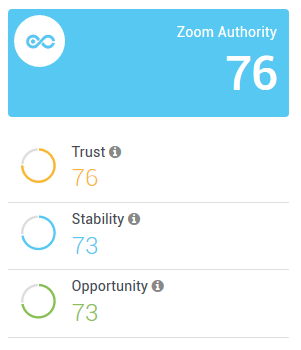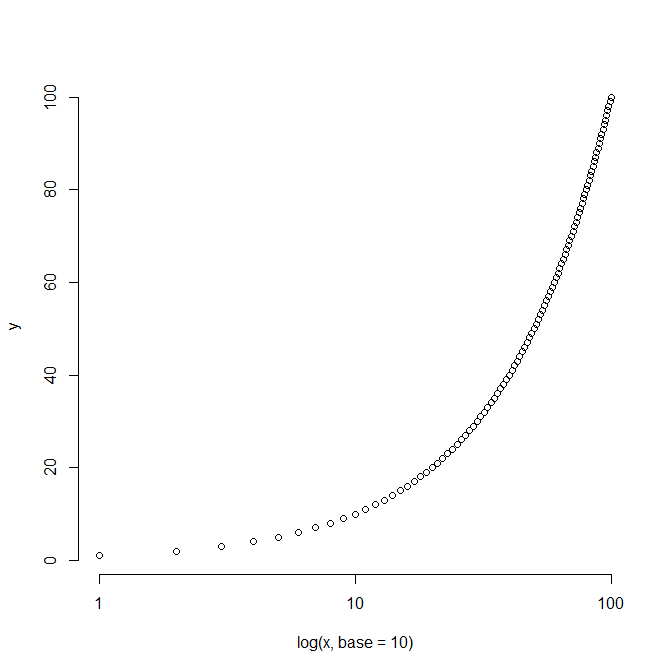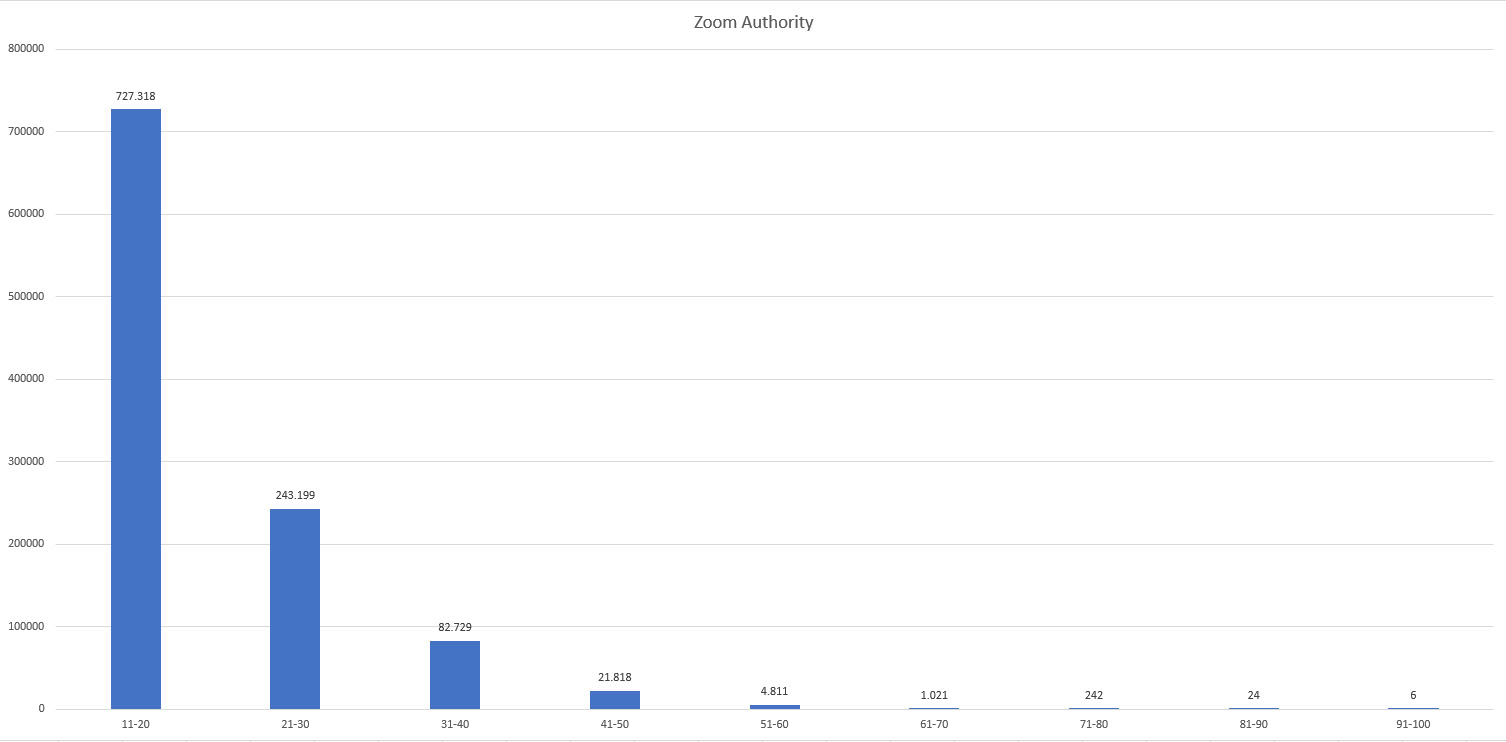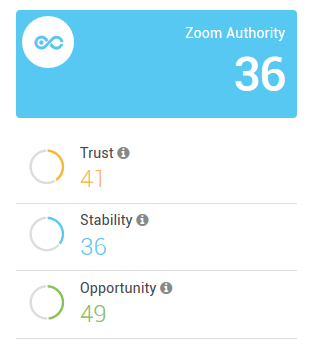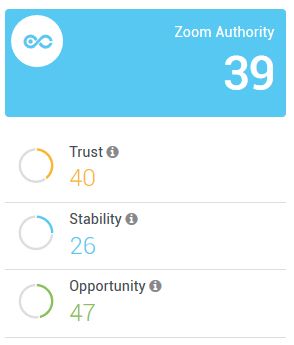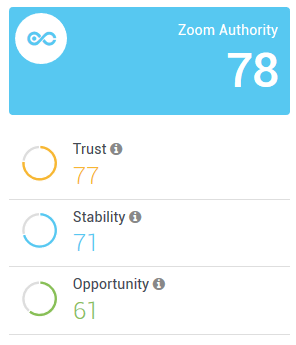How to interpret the Zoom Authority
Zoom Authority is a metric precisely designed to analyze, in a glance, the health level of a web site and its performance on Google Research.
Often people ask us for clarifications on how the metric is calculated and, mainly, how can one understand if the Zoom Authority value of a site is good news or not.
First of all, the premise is that the metric is calculated based on the data of every single domain listed on our database, hence representing a fully-fledged ranking of the domain among the whole web scenery.
On this article I will try and use an extremely simple language, avoiding complex mathematical concepts, in order to be the clearest possible in sorting out any doubt.
How is Zoom Authority calculated
In order to evaluate a web site we took into account a series of important signals, supplied by search engines, without ever trying to invent evaluation algorithms, that would then never meet any feedback with the real site trend.
Often, whenever trying to evaluate a web site with personal speculations, such as the number or the quality of the backlinks it receives, one then clashes with reality and frequently such web sites are not ranked for any important keyword and are not obtaining any organic traffic.
For this very reason we completely excluded backlinks from our Zoom Authority evaluation. Only Google knows exactly how to evaluate backlinks and would be pretty presumptuous to make an assumption and evaluate a web site based on its backlinks without any proper foundation.
The signals took into account by Zoom Authority are the following:
- Traffic from search engines
- Trust (the kind of trust shown by Google in the specific web site)
- Stability (how stable the web site’s organic rank is)
- Opportunity (how much can the web site further grow on months to come)
Excluding traffic, fairly simple to assess based on ranking, there are other factors to dwell on given the fact that their calculation is performed separately with deep evaluations.
Domain’s Trust
The question we asked ourselves was: “How much does Google trust this specific domain? How can we measure that?”
In order to get an answer we analyzed the ranking of every single domain listed on our database and we compared them with each other. This way we figured out how much Google is actually rewarding a web site on rankings but mainly we succeeded in creating an algorithm able to tell us, on a 0-100 scale, how much Google trusts the mentioned site placing it – or not – in privileged positions compared to other sites.
The trust metric, has a strictly analytic basis and sums up in a single value its answer to the starting question, that is: “How much does Google trust this site on a 0-100 scale?”
We will later see, for each metric, how to interpret every possible value.
Organic ranking stability
To only evaluate a site web based on its traffic would be very superficial, so we thought about a second fundamental signal, the site’s ranking stability.
A web site with a stable ranking can rely on plenty of first-page-ranked keywords on higher positions. If a specific keyword should lose its rank, the web site does not risk to collapse, so we can say it has a stable ranking.
If, on the other hand, a web site with high traffic only has a handful top keywords inside Google’s top 10, then we could say that it does surely not have a stable ranking and if a single keyword should drop it risks to lose the mojority of its traffic.
I have deliberately explained the entire stability assessment in a simplistic way but the parameters that lead to the actual generation of these values really are accurate and a lot and they are part of pretty complex algorithm.
In this case as well, our metric answers a simple question: “How much stable is ranking on a 0-100 scale?”
Opportunity of site traffic
Every web site acquires traffic, has a more or less stable ranking based on those keywords it successfully brought in the top 10 but also has some chance to improve its ranking and traffic over time.
We have considered important this factor as integral part of the Zoom Authority in order to give a plus to promising web sites compared to those that instead do not have any big possibilities of enhancement.
While to evaluate stability we took into account ranked keywords, to identify opportunities we analyzed quantity and quality of the keywords not yet ranked on first page and the probability that one day they could reach it.
Like any previous case, the metric answers to a question: “What kind of probability does the site have to improve its ranking on a 0-100 scale?”
Here we get to Zoom Authority
Every evaluation factor mentioned so far is individually calculated with assessment algorithms that precisely mirror the assessment a SEO expert would have done, they are not “imaginative” algorithms but true and proper numerical evaluations about sites’ trends and ratioed on scale among the values of all other web sites.
We do not really consider each and every factor, represented by a 0-100 scale value, could have the exact same specific weight of the others.
On Zoom Authority’s calculation we give a specific weight to each factor, hence ZA is absolutely not the average of the values of all other factors.
You could therefore find a web site with ZA 76 but with a stability factor equal to 33. This is pivotal to perform accurate evaluations on any web site, and at the end of the article I will provide you with some sample values trying to then interpret the typology of the site we are talking about.
At the beginning, inside SEOZoom we used to only show the final Zoom Authority value but then we decided to also provide you with the individual evaluations of the most important factors we take into account. It is very useful to have an immediate and complete assessment of any kind of web site, both for personal use that during web sites’ evaluation for Backlink acquisition.
How to read Zoom Authority
In order to know if a ZA value is good or not it is necessary to understand the concept used as basis for this particular metric’s creation.
As previously mentioned, Zoom Authority’s value is based on a 0-100 scale and takes into account the metrics of every single domain listed inside our database as reference point to get to the final computation.
The biggest majority of web sites that get poor results on search engines is sorted within the Zoom Authority range from 0 to 30 points. To achieve a ZA increase in this particular range is extremely easy but when you reach, like, 50 ZA points, even the improvement of a single point becomes more and more difficult given the fact that big enhancements of internal metrics will now be required.
To better understand how to assess if a domain’s ZA is good or not I will now show you the distribution of all the domains listed in SEOZoom in the different ranges of Zoom Authority.
As you can see from the tab above, only 6 domains have a ZA higher than 90, while the biggest majority of them have a ZA lower than 10.
If your site has a ZA 55, you can surely consider it as a great result given the fact that this places it among those 4811 web sites with a ZA from 51 to 60.
Looking at the graph above, it is even more blatant how much a particular ZA value could be considerate as “elite” or pretty common.
Some Zoom Authority’s evaluation samples
Our specific domain has a ZA 36, there are more or less 82.729 others in its same predicament and this places it on a average-low level, but what we can observe is:
- The site has a Trust value of 41, therefore is fairly rewarded by Google
- It has a ranking stability below average
- It also has average opportunities
In a glance we could say that the site is generating traffic, it is fairly rewarded by Google, but it is actually generating that traffic with a limited number of keywords and, for this very reason, it could easily lose traffic in the event of some important keyword’s decline. We also notice, though, that the site is currently running for the ranking of a good number of keywords because of the Opportunity value of 49, hence there still is room for improvement.
Our second analyzed domain has a higher Zoom Authority than the previous one and a closer Trust, but shows an obvious problem: its ranking is extremely unstable. It is generating traffic with a limited number of keywords and could lose it quickly.
Our third analyzed domain is very much rewarded by Google, owns a pretty stable ranking and plenty opportunities to further grow in the future.
For any further question, I will be more than happy to answer in the comment section below.


